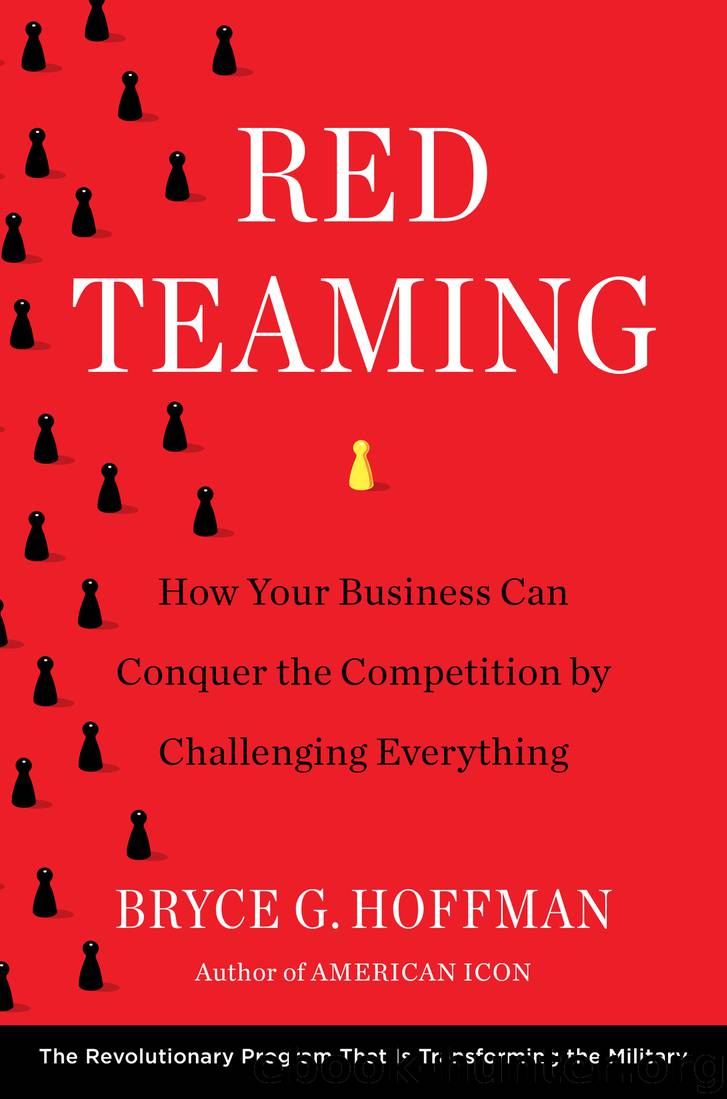Red Teaming by Bryce G. Hoffman

Author:Bryce G. Hoffman
Language: eng
Format: epub
Publisher: The Crown Publishing Group
Published: 2017-05-15T16:00:00+00:00
To make sure problems are framed correctly, the U.S. Army teaches red teamers to start by examining the issue under review from a variety of different angles. This can be as simple as paraphrasing the problem, because using different words to describe the problem can often yield valuable new perspectives. For example, if you were asked, How can we ensure our patented process remains the industry’s first choice? you might restate the problem more bluntly: We believe there is no better process possible than ours, but we’re worried someone will invent one. If you did, it would reveal the assumption inherent in the original question—that the company cannot improve its process. Hopefully, it would also lead your red team to answer the more important question: Is there any way to do what we do better, faster, or cheaper? Because if you answer that question first, not only will you not have to worry about your competitors, but you will also strengthen your fundamental business.
Other ways of restating a problem include broadening its focus to place it in a bigger context (e.g., instead of: How do we grow our business by expanding in China? framing the problem as: How do we grow our business in Asia?) or shifting the focus entirely (e.g., rather than asking, How can we increase sales? ask, How can we reduce costs, and thereby increase profits?). Turning a problem on its head can also yield valuable insights and new perspectives. For example, instead of asking, How can we use Six Sigma to improve our quality while boosting productivity? you might ask, How can we reduce our quality and lower our productivity using Six Sigma? If you did, you might discover that the original question was not really about improving quality and boosting productivity, but about how to employ Six Sigma.
Examining problems in this way requires healthy discussion and a free flow of ideas. The best way to encourage that is to begin with divergent thinking and work toward convergent thinking.
Download
This site does not store any files on its server. We only index and link to content provided by other sites. Please contact the content providers to delete copyright contents if any and email us, we'll remove relevant links or contents immediately.
Rich Dad Poor Dad by Robert T. Kiyosaki(6174)
Pioneering Portfolio Management by David F. Swensen(6078)
How To Win Friends and Influence People by Dale Carnegie(4330)
The Money Culture by Michael Lewis(3843)
The Dhandho Investor by Mohnish Pabrai(3560)
The Wisdom of Finance by Mihir Desai(3523)
Liar's Poker by Michael Lewis(3220)
The Intelligent Investor by Benjamin Graham Jason Zweig(2930)
The ONE Thing by Gary Keller(2917)
Mastering Bitcoin: Programming the Open Blockchain by Andreas M. Antonopoulos(2890)
Fooled by Randomness: The Hidden Role of Chance in Life and in the Markets by Nassim Nicholas Taleb(2860)
Rich Dad Poor Dad: What The Rich Teach Their Kids About Money - That The Poor And Middle Class Do Not! by Robert T. Kiyosaki(2833)
How to Win Friends and Influence People by Dale Carnegie(2792)
Investing For Dummies by Eric Tyson(2789)
How to Day Trade for a Living: Tools, Tactics, Money Management, Discipline and Trading Psychology by Andrew Aziz(2784)
Market Wizards by Jack D. Schwager(2538)
Zero Hour by Harry S. Dent Jr. & Andrew Pancholi(2531)
How to Pay Zero Taxes, 2018 by Jeff A. Schnepper(2496)
Rich Dad's Guide to Investing by Robert T. Kiyosaki(2410)
